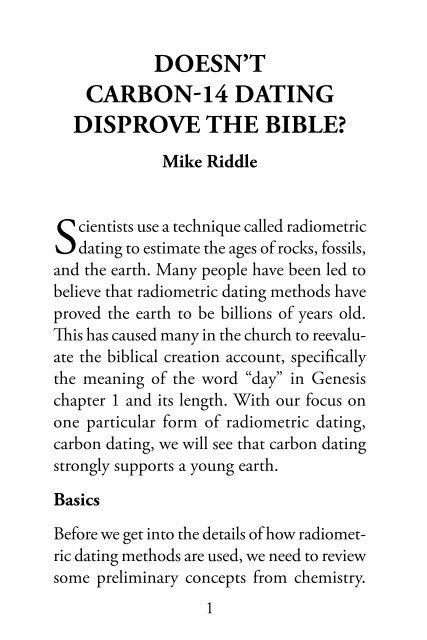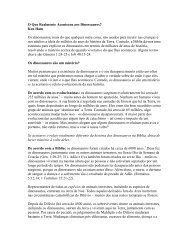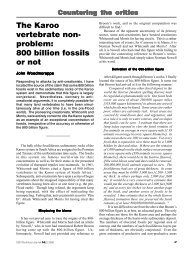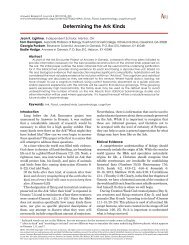Doesn't Carbon-14 Dating Disprove the bible? - Answers in Genesis
Doesn't Carbon-14 Dating Disprove the bible? - Answers in Genesis
Doesn't Carbon-14 Dating Disprove the bible? - Answers in Genesis
You also want an ePaper? Increase the reach of your titles
YUMPU automatically turns print PDFs into web optimized ePapers that Google loves.
Doesn’t<br />
<strong>Carbon</strong>-<strong>14</strong> <strong>Dat<strong>in</strong>g</strong><br />
<strong>Disprove</strong> <strong>the</strong> <strong>bible</strong>?<br />
Mike riddle<br />
Scientists use a technique called radiometric<br />
dat<strong>in</strong>g to estimate <strong>the</strong> ages of rocks, fossils,<br />
and <strong>the</strong> earth. Many people have been led to<br />
believe that radiometric dat<strong>in</strong>g methods have<br />
proved <strong>the</strong> earth to be billions of years old.<br />
This has caused many <strong>in</strong> <strong>the</strong> church to reevaluate<br />
<strong>the</strong> biblical creation account, specifically<br />
<strong>the</strong> mean<strong>in</strong>g of <strong>the</strong> word “day” <strong>in</strong> <strong>Genesis</strong><br />
chapter and its length. With our focus on<br />
one particular form of radiometric dat<strong>in</strong>g,<br />
carbon dat<strong>in</strong>g, we will see that carbon dat<strong>in</strong>g<br />
strongly supports a young earth.<br />
basics<br />
Before we get <strong>in</strong>to <strong>the</strong> details of how radiometric<br />
dat<strong>in</strong>g methods are used, we need to review<br />
some prelim<strong>in</strong>ary concepts from chemistry.
-<br />
-<br />
-<br />
+<br />
+<br />
+<br />
-<br />
<strong>Carbon</strong> atom<br />
-<br />
Recall that atoms are <strong>the</strong> basic build<strong>in</strong>g<br />
blocks of matter. Atoms are made up of much<br />
smaller particles called protons, neutrons, and<br />
electrons. Protons and neutrons make up <strong>the</strong><br />
center (nucleus) of <strong>the</strong> atom, and electrons<br />
form shells around <strong>the</strong> nucleus.<br />
The number of protons <strong>in</strong> <strong>the</strong> nucleus of an<br />
atom determ<strong>in</strong>es <strong>the</strong> element. For example,<br />
all carbon atoms have 6 protons, all atoms of<br />
nitrogen have 7 protons, and all oxygen atoms<br />
have 8 protons. The number of neutrons <strong>in</strong> <strong>the</strong><br />
nucleus can vary <strong>in</strong> any given type of atom.<br />
So, a carbon atom might have six neutrons, or<br />
-<br />
6 proton<br />
+ 6 neutrons<br />
-<br />
+<br />
electron<br />
proton<br />
neutron
seven, or possibly eight—but it would always<br />
have six protons. An “isotope” is any of several<br />
different forms of an element, each hav<strong>in</strong>g different<br />
numbers of neutrons. The illustration<br />
below shows <strong>the</strong> three isotopes of carbon.<br />
Atomic mass<br />
Atomic number<br />
12<br />
6<br />
<strong>Carbon</strong>-12<br />
6<br />
<strong>Carbon</strong>-13<br />
The atomic number corresponds to <strong>the</strong> number of protons <strong>in</strong> an<br />
atom. Atomic mass is a comb<strong>in</strong>ation of <strong>the</strong> number of protons and<br />
neutrons <strong>in</strong> <strong>the</strong> nucleus. (The electrons are so much lighter that<br />
<strong>the</strong>y do not contribute significantly to <strong>the</strong> mass of an atom.)<br />
Some isotopes of certa<strong>in</strong> elements are unstable;<br />
<strong>the</strong>y can spontaneously change <strong>in</strong>to ano<strong>the</strong>r<br />
k<strong>in</strong>d of atom <strong>in</strong> a process called “radioactive<br />
decay.” S<strong>in</strong>ce this process happens at a<br />
known rate, scientists attempt to use it like<br />
a “clock” to tell how long ago a rock or fossil<br />
formed. There are two ma<strong>in</strong> applications for<br />
radiometric dat<strong>in</strong>g. One is for dat<strong>in</strong>g fossils<br />
(once-liv<strong>in</strong>g th<strong>in</strong>gs) us<strong>in</strong>g carbon- 4 dat<strong>in</strong>g,<br />
and <strong>the</strong> o<strong>the</strong>r is for dat<strong>in</strong>g rocks and <strong>the</strong> age<br />
of <strong>the</strong> earth.<br />
13<br />
<strong>14</strong><br />
6<br />
<strong>Carbon</strong>-<strong>14</strong>
<strong>Carbon</strong>-<strong>14</strong> <strong>Dat<strong>in</strong>g</strong><br />
<strong>Carbon</strong>- 4 ( 4 C), also referred to as radiocarbon,<br />
is claimed to be a reliable dat<strong>in</strong>g method<br />
for determ<strong>in</strong><strong>in</strong>g <strong>the</strong> age of fossils up to<br />
50,000 to 60,000 years. If this claim is true,<br />
<strong>the</strong> biblical account of a young earth (about<br />
6,000 years) is <strong>in</strong> question, s<strong>in</strong>ce 4 C dates of<br />
tens of thousands of years are common.<br />
When a scientist’s <strong>in</strong>terpretation of data does<br />
not match <strong>the</strong> clear mean<strong>in</strong>g of <strong>the</strong> text <strong>in</strong> <strong>the</strong><br />
Bible, we should never re<strong>in</strong>terpret <strong>the</strong> Bible.<br />
God knows just what He meant to say, and<br />
His understand<strong>in</strong>g of science is <strong>in</strong>fallible,<br />
whereas ours is fallible. So we should never<br />
th<strong>in</strong>k it necessary to modify His Word. <strong>Genesis</strong><br />
chapter def<strong>in</strong>es <strong>the</strong> days of creation to<br />
be literal days (<strong>the</strong> use of a number with <strong>the</strong><br />
word “day” always means a normal day <strong>in</strong> <strong>the</strong><br />
Old Testament, and <strong>the</strong> phrase “even<strong>in</strong>g and<br />
morn<strong>in</strong>g” fur<strong>the</strong>r def<strong>in</strong>es <strong>the</strong> days as literal<br />
days). S<strong>in</strong>ce <strong>the</strong> Bible is <strong>the</strong> <strong>in</strong>spired Word<br />
of God, we should exam<strong>in</strong>e <strong>the</strong> validity of<br />
<strong>the</strong> standard <strong>in</strong>terpretation of 4 C dat<strong>in</strong>g by<br />
4
ask<strong>in</strong>g several questions:<br />
. Is <strong>the</strong> explanation of <strong>the</strong> data derived<br />
from empirical, observational science, or<br />
an <strong>in</strong>terpretation of past events (historical<br />
science)?<br />
. Are <strong>the</strong>re any assumptions <strong>in</strong>volved <strong>in</strong> <strong>the</strong><br />
dat<strong>in</strong>g method?<br />
. Are <strong>the</strong> dates provided by 4C dat<strong>in</strong>g<br />
consistent with what we observe?<br />
4. Do all scientists accept <strong>the</strong> 4C dat<strong>in</strong>g<br />
method as reliable and accurate?<br />
All radiometric dat<strong>in</strong>g methods use scientific<br />
procedures <strong>in</strong> <strong>the</strong> present to <strong>in</strong>terpret what<br />
has happened <strong>in</strong> <strong>the</strong> past. The procedures<br />
used are not necessarily <strong>in</strong> question. The<br />
<strong>in</strong>terpretation of past events is <strong>in</strong> question. The<br />
secular (evolutionary) worldview <strong>in</strong>terprets <strong>the</strong><br />
universe and world to be billions of years old.<br />
The Bible teaches a young universe and earth.<br />
Which worldview does science support? Can<br />
carbon- 4 dat<strong>in</strong>g help solve <strong>the</strong> mystery of<br />
which worldview is more accurate?<br />
5
The use of carbon- 4 dat<strong>in</strong>g is often misunderstood.<br />
<strong>Carbon</strong>- 4 is mostly used to date onceliv<strong>in</strong>g<br />
th<strong>in</strong>gs (organic material). It cannot be<br />
used directly to date rocks; however, it can be<br />
used to put time constra<strong>in</strong>ts on some <strong>in</strong>organic<br />
material such as diamonds (diamonds conta<strong>in</strong><br />
carbon- 4). Because of <strong>the</strong> rapid rate of decay<br />
of 4 C, it can only give dates <strong>in</strong> <strong>the</strong> thousandsof-year<br />
range and not millions.<br />
There are three different naturally occurr<strong>in</strong>g varieties<br />
(isotopes) of carbon: C, C, and 4 C.<br />
Proton Neutron Electron<br />
C-12 Stable C-13 Stable C-<strong>14</strong> Unstable<br />
<strong>Carbon</strong>- 4 is used for dat<strong>in</strong>g because it is<br />
unstable (radioactive), whereas C and C<br />
are stable. Radioactive means that 4 C will<br />
decay (emit radiation) over time and become<br />
a different element. Dur<strong>in</strong>g this process<br />
6
(called “beta decay”) a neutron <strong>in</strong> <strong>the</strong> 4 C<br />
atom will be converted <strong>in</strong>to a proton. By<br />
los<strong>in</strong>g one neutron and ga<strong>in</strong><strong>in</strong>g one proton,<br />
4 C is changed <strong>in</strong>to nitrogen- 4 ( 4 N = 7<br />
protons and 7 neutrons).<br />
If 4 C is constantly decay<strong>in</strong>g, will <strong>the</strong> earth<br />
eventually run out of 4 C? The answer is<br />
no. <strong>Carbon</strong>- 4 is constantly be<strong>in</strong>g added<br />
to <strong>the</strong> atmosphere. Cosmic rays from outer<br />
space, which conta<strong>in</strong> high levels of energy,<br />
bombard <strong>the</strong> earth’s upper atmosphere.<br />
These cosmic rays collide with atoms <strong>in</strong> <strong>the</strong><br />
atmosphere and can cause <strong>the</strong>m to come<br />
apart. Neutrons that come from <strong>the</strong>se fragmented<br />
atoms collide with 4 N atoms (<strong>the</strong><br />
atmosphere is made mostly of nitrogen and<br />
oxygen) and convert <strong>the</strong>m <strong>in</strong>to 4 C atoms<br />
(a proton changes <strong>in</strong>to a neutron).<br />
Once 4 C is produced,<br />
it comb<strong>in</strong>es<br />
with oxygen <strong>in</strong> <strong>the</strong><br />
atmosphere ( C<br />
behaves like 4 C and<br />
also comb<strong>in</strong>es with<br />
7
oxygen) to form<br />
carbon dioxide<br />
(CO ). Because<br />
CO gets <strong>in</strong>corporated<br />
<strong>in</strong>to plants<br />
(which means <strong>the</strong><br />
food we eat conta<strong>in</strong>s<br />
4 C and C),<br />
all liv<strong>in</strong>g th<strong>in</strong>gs<br />
should have <strong>the</strong><br />
same ratio of 4 C<br />
and C <strong>in</strong> <strong>the</strong>m as<br />
<strong>in</strong> <strong>the</strong> air we brea<strong>the</strong>.<br />
how <strong>the</strong> <strong>Carbon</strong>-<strong>14</strong> <strong>Dat<strong>in</strong>g</strong><br />
proCess works<br />
Once a liv<strong>in</strong>g th<strong>in</strong>g<br />
dies, <strong>the</strong> dat<strong>in</strong>g<br />
process beg<strong>in</strong>s. As<br />
long as an organism<br />
is alive it will<br />
cont<strong>in</strong>ue to take<br />
<strong>in</strong> 4 C; however,<br />
when it dies, it will stop. S<strong>in</strong>ce 4 C is radio-<br />
8
active (decays <strong>in</strong>to<br />
4 N), <strong>the</strong> amount<br />
of 4 C <strong>in</strong> a dead<br />
organism gets less<br />
and less over time.<br />
Therefore, part of<br />
<strong>the</strong> dat<strong>in</strong>g process<br />
<strong>in</strong>volves measur<strong>in</strong>g <strong>the</strong> amount of 4 C that<br />
rema<strong>in</strong>s after some has been lost (decayed).<br />
Scientists now use a device called an “Accelerator<br />
Mass Spectrometer” (AMS) to determ<strong>in</strong>e<br />
<strong>the</strong> ratio of 4 C to C, which <strong>in</strong>creases<br />
<strong>the</strong> assumed accuracy to about 80,000 years.<br />
In order to actually do <strong>the</strong> dat<strong>in</strong>g, o<strong>the</strong>r<br />
th<strong>in</strong>gs need to be known. Two such th<strong>in</strong>gs<br />
<strong>in</strong>clude <strong>the</strong> follow<strong>in</strong>g questions:<br />
. How fast does 4 C decay?<br />
. What was <strong>the</strong> start<strong>in</strong>g amount of 4 C <strong>in</strong><br />
<strong>the</strong> creature when it died?<br />
The decay rate of radioactive elements is<br />
described <strong>in</strong> terms of half-life. The half-life of<br />
an atom is <strong>the</strong> amount of time it takes for half<br />
of <strong>the</strong> atoms <strong>in</strong> a sample to decay. The half-life
Start<strong>in</strong>g amount<br />
of C-<strong>14</strong><br />
Current amount<br />
of C-<strong>14</strong><br />
Half-life of C-<strong>14</strong><br />
Known<br />
Known<br />
of 4C is 5,7 0 years. For example, a jar start<strong>in</strong>g<br />
with all 4C atoms at time zero will conta<strong>in</strong><br />
half 4C atoms and half 4N atoms at <strong>the</strong> end<br />
of 5,7 0 years (one half-life).<br />
At <strong>the</strong> end of ,460 years (two half-lives) <strong>the</strong><br />
jar will conta<strong>in</strong> one-quarter 4C atoms and<br />
three-quarter 4N atoms.<br />
S<strong>in</strong>ce <strong>the</strong> half-life of 4C is known (how fast<br />
it decays), <strong>the</strong> only part left to determ<strong>in</strong>e<br />
is <strong>the</strong> start<strong>in</strong>g amount of 4C <strong>in</strong> a fossil. If<br />
scientists know <strong>the</strong> orig<strong>in</strong>al amount of 4C <strong>in</strong> a creature when it died, <strong>the</strong>y can measure<br />
<strong>the</strong> current amount and <strong>the</strong>n calculate how<br />
many half-lives have passed.<br />
S<strong>in</strong>ce no one was <strong>the</strong>re to measure <strong>the</strong> amount<br />
of 4C when a creature died, scientists need to<br />
0<br />
�ree pieces of data needed<br />
to calculate <strong>the</strong> number of<br />
half-lives or age of <strong>the</strong><br />
creature
f<strong>in</strong>d a method to determ<strong>in</strong>e how much 4 C has<br />
decayed. To do this, scientists use <strong>the</strong> ma<strong>in</strong><br />
isotope of carbon, called carbon- ( C).<br />
Because C is a stable isotope of carbon, it<br />
will rema<strong>in</strong> constant; however, <strong>the</strong> amount<br />
of 4 C will decrease after a creature dies. All<br />
liv<strong>in</strong>g th<strong>in</strong>gs take <strong>in</strong> carbon ( 4 C and C) from<br />
eat<strong>in</strong>g and breath<strong>in</strong>g.<br />
Therefore, <strong>the</strong> ratio of 4 C to C <strong>in</strong> liv<strong>in</strong>g<br />
creatures will be <strong>the</strong> same as <strong>in</strong> <strong>the</strong> atmosphere.<br />
This ratio turns out to be about one 4 C atom<br />
for every trillion C atoms. Scientists can<br />
use this ratio to help determ<strong>in</strong>e <strong>the</strong> start<strong>in</strong>g<br />
amount of 4 C.<br />
When an organism dies, this ratio ( to trillion)<br />
will beg<strong>in</strong> to change. The amount of C<br />
will rema<strong>in</strong> constant, but <strong>the</strong> amount of 4 C<br />
will become less and less. The smaller <strong>the</strong> ratio,<br />
<strong>the</strong> longer <strong>the</strong> organism has been dead.<br />
The follow<strong>in</strong>g illustration demonstrates how<br />
<strong>the</strong> age is estimated us<strong>in</strong>g this ratio.
percent <strong>14</strong>C<br />
rema<strong>in</strong><strong>in</strong>g<br />
(age of Fossil)<br />
percent 12C<br />
rema<strong>in</strong><strong>in</strong>g<br />
ratio<br />
number of<br />
half-lives<br />
00 50 5 .5 6. 5 . 5<br />
00 00 00 00 00 00<br />
to<br />
T<br />
to<br />
T<br />
to 4T to 8T<br />
to<br />
6T<br />
0 4 5<br />
Years Dead 0 5,7 0 ,460 7, 0 , 0 8,650<br />
a Critical assumption<br />
A critical assumption used <strong>in</strong> carbon- 4 dat<strong>in</strong>g<br />
has to do with this ratio. It is assumed that <strong>the</strong><br />
ratio of 4 C to C <strong>in</strong> <strong>the</strong> atmosphere has always<br />
been <strong>the</strong> same as it is today ( to trillion).<br />
If this assumption is true, <strong>the</strong>n <strong>the</strong> AMS 4 C<br />
dat<strong>in</strong>g method is valid up to about 80,000 years.<br />
Beyond this number, <strong>the</strong> <strong>in</strong>struments scientists<br />
use would not be able to detect enough rema<strong>in</strong><strong>in</strong>g<br />
4 C to be useful <strong>in</strong> age estimates. This is a<br />
critical assumption <strong>in</strong> <strong>the</strong> dat<strong>in</strong>g process. If this<br />
assumption is not true, <strong>the</strong>n <strong>the</strong> method will<br />
give <strong>in</strong>correct dates.<br />
What could cause this ratio to change? If <strong>the</strong> pro-<br />
to<br />
T<br />
T = Trillion
duction rate of 4 C <strong>in</strong> <strong>the</strong> atmosphere is not equal<br />
to <strong>the</strong> removal rate (mostly through decay), this<br />
ratio will change. In o<strong>the</strong>r words, <strong>the</strong> amount<br />
of 4 C be<strong>in</strong>g produced <strong>in</strong> <strong>the</strong> atmosphere must<br />
equal <strong>the</strong> amount be<strong>in</strong>g removed to be <strong>in</strong> a<br />
steady state (also called “equilibrium”). If this is<br />
not true, <strong>the</strong> ratio of 4 C to C is not a constant,<br />
which would make know<strong>in</strong>g <strong>the</strong> start<strong>in</strong>g amount<br />
of 4 C <strong>in</strong> a specimen difficult or impossible to<br />
accurately determ<strong>in</strong>e.<br />
Dr. Willard Libby, <strong>the</strong> founder of <strong>the</strong> carbon-<br />
4 dat<strong>in</strong>g method, assumed this ratio to be<br />
constant. His reason<strong>in</strong>g was based on a belief<br />
<strong>in</strong> evolution, which assumes <strong>the</strong> earth must<br />
be billions of years old. Assumptions <strong>in</strong> <strong>the</strong><br />
scientific community are extremely important.<br />
If <strong>the</strong> start<strong>in</strong>g assumption is false, all <strong>the</strong> calculations<br />
based on that assumption might be<br />
correct but still give a wrong conclusion.<br />
In Dr. Libby’s orig<strong>in</strong>al work, he noted that<br />
<strong>the</strong> atmosphere did not appear to be <strong>in</strong><br />
equilibrium. This was a troubl<strong>in</strong>g idea for<br />
Dr. Libby s<strong>in</strong>ce he believed <strong>the</strong> world was<br />
billions of years old and enough time had
passed to achieve equilibrium. Dr. Libby’s<br />
calculations showed that if <strong>the</strong> earth started<br />
with no 4 C <strong>in</strong> <strong>the</strong> atmosphere, it would take<br />
up to 0,000 years to build up to a steady state<br />
(equilibrium).<br />
If <strong>the</strong> cosmic radiation has rema<strong>in</strong>ed<br />
at its present <strong>in</strong>tensity for 0,000 or<br />
0,000 years, and if <strong>the</strong> carbon reservoir<br />
has not changed appreciably <strong>in</strong><br />
this time, <strong>the</strong>n <strong>the</strong>re exists at <strong>the</strong> present<br />
time a complete balance between<br />
<strong>the</strong> rate of dis<strong>in</strong>tegration of radiocarbon<br />
atoms and <strong>the</strong> rate of assimilation<br />
of new radiocarbon atoms for all<br />
material <strong>in</strong> <strong>the</strong> life-cycle.<br />
Dr. Libby chose to ignore this discrepancy<br />
(i.e., <strong>the</strong> nonequilibrium state), and he attributed<br />
it to experimental error. However, <strong>the</strong><br />
discrepancy has turned out to be very real. The<br />
ratio of 4 C / C is not constant.<br />
The Specific Production Rate (SPR) of<br />
C- 4 is known to be 8.8 atoms per<br />
gram of total carbon per m<strong>in</strong>ute. The<br />
4
Specific Decay Rate (SDR) is known<br />
to be only 6. dis<strong>in</strong>tegrations per<br />
gram per m<strong>in</strong>ute.<br />
What does this mean? If it takes about 0,000<br />
years to reach equilibrium and 4 C is still out<br />
of equilibrium, <strong>the</strong>n maybe <strong>the</strong> earth is not<br />
very old.<br />
Magnetic Field of <strong>the</strong> earth<br />
O<strong>the</strong>r factors can affect <strong>the</strong> production rate<br />
of 4 C <strong>in</strong> <strong>the</strong> atmosphere. The earth has a<br />
magnetic field around it which helps protect us<br />
from harmful radiation from outer space. This<br />
magnetic field is decay<strong>in</strong>g (gett<strong>in</strong>g weaker).<br />
The stronger <strong>the</strong> field is around <strong>the</strong> earth, <strong>the</strong><br />
fewer <strong>the</strong> number of cosmic rays that are able<br />
to reach <strong>the</strong> atmosphere. This would result <strong>in</strong><br />
a smaller production of 4 C <strong>in</strong> <strong>the</strong> atmosphere<br />
<strong>in</strong> earth’s past.<br />
The cause for <strong>the</strong> long term variation<br />
of <strong>the</strong> C- 4 level is not known.<br />
The variation is certa<strong>in</strong>ly partially<br />
<strong>the</strong> result of a change <strong>in</strong> <strong>the</strong> cosmic<br />
5
ay production rate of radiocarbon.<br />
The cosmic-ray flux, and hence <strong>the</strong><br />
production rate of C- 4, is a function<br />
not only of <strong>the</strong> solar activity but<br />
also of <strong>the</strong> magnetic dipole moment<br />
of <strong>the</strong> Earth. 4<br />
Though complex, this history of <strong>the</strong><br />
earth’s magnetic field agrees with<br />
Barnes’ basic hypo<strong>the</strong>sis, that <strong>the</strong> field<br />
has always freely decayed … . The<br />
field has always been los<strong>in</strong>g energy<br />
despite its variations, so it cannot be<br />
more than 0,000 years old. 5<br />
Earth’s magnetic field is fad<strong>in</strong>g. Today<br />
it is about 0 percent weaker than it<br />
was when German ma<strong>the</strong>matician<br />
Carl Friedrich Gauss started keep<strong>in</strong>g<br />
tabs on it <strong>in</strong> 845, scientists say. 6<br />
If <strong>the</strong> production rate of 4 C <strong>in</strong> <strong>the</strong> atmosphere<br />
was less <strong>in</strong> <strong>the</strong> past, dates given us<strong>in</strong>g <strong>the</strong><br />
carbon- 4 method would <strong>in</strong>correctly assume<br />
that more 4 C had decayed out of a specimen<br />
than what has actually occurred. This would<br />
6
esult <strong>in</strong> giv<strong>in</strong>g older dates than <strong>the</strong> true age.<br />
genesis Flood<br />
What role might <strong>the</strong> <strong>Genesis</strong> Flood have<br />
played <strong>in</strong> <strong>the</strong> amount of carbon? The Flood<br />
would have buried large amounts of carbon<br />
from liv<strong>in</strong>g organisms (plant and animal) to<br />
form today’s fossil fuels (coal, oil, etc.). The<br />
amount of fossil fuels <strong>in</strong>dicates <strong>the</strong>re must<br />
have been a vastly larger quantity of vegetation<br />
<strong>in</strong> existence prior to <strong>the</strong> Flood than exists<br />
today. This means that <strong>the</strong> biosphere just prior<br />
to <strong>the</strong> Flood might have had 500 times more<br />
carbon <strong>in</strong> liv<strong>in</strong>g organisms than today. This<br />
would fur<strong>the</strong>r dilute <strong>the</strong> amount of 4 C and<br />
cause <strong>the</strong> 4 C / C ratio to be much smaller<br />
than today.<br />
If that were <strong>the</strong> case, and this C- 4<br />
were distributed uniformly throughout<br />
<strong>the</strong> biosphere, and <strong>the</strong> total amount<br />
of biosphere C were, for example,<br />
500 times that of today’s world, <strong>the</strong><br />
result<strong>in</strong>g C- 4/C- ratio would be<br />
/500 of today’s level … . 7<br />
7
When <strong>the</strong> Flood is taken <strong>in</strong>to account along<br />
with <strong>the</strong> decay of <strong>the</strong> magnetic field, it is<br />
reasonable to believe that <strong>the</strong> assumption of<br />
equilibrium is a false assumption.<br />
Because of this false assumption, any age estimates<br />
us<strong>in</strong>g 4 C prior to <strong>the</strong> Flood will give<br />
much older dates than <strong>the</strong> true age. Pre-Flood<br />
material would be dated at perhaps ten times<br />
<strong>the</strong> true age.<br />
The rate group F<strong>in</strong>d<strong>in</strong>gs<br />
In 7 an eight-year research project was<br />
started to <strong>in</strong>vestigate <strong>the</strong> age of <strong>the</strong> earth. The<br />
group was called <strong>the</strong> RATE group (Radioisotopes<br />
and <strong>the</strong> Age of The Earth). The team of<br />
scientists <strong>in</strong>cluded:<br />
Larry Vardiman, PhD Atmospheric Science<br />
Russell Humphreys, PhD Physics<br />
Eugene Chaff<strong>in</strong>, PhD Physics<br />
John Baumgardner, PhD Geophysics<br />
Donald DeYoung, PhD Physics<br />
8
Steven Aust<strong>in</strong>, PhD Geology<br />
Andrew Snell<strong>in</strong>g, PhD Geology<br />
Steven Boyd, PhD Hebraic and Cognate Studies<br />
The objective was to ga<strong>the</strong>r data commonly<br />
ignored or censored by evolutionary<br />
standards of dat<strong>in</strong>g. The scientists reviewed<br />
<strong>the</strong> assumptions and procedures used <strong>in</strong><br />
estimat<strong>in</strong>g <strong>the</strong> ages of rocks and fossils. The<br />
results of <strong>the</strong> carbon- 4 dat<strong>in</strong>g demonstrated<br />
serious problems for long geologic ages.<br />
Samples were taken from ten different<br />
coal layers that, accord<strong>in</strong>g to evolutionists,<br />
represent different time periods <strong>in</strong> <strong>the</strong> geologic<br />
column (Cenozoic, Mesozoic, and Paleozoic).<br />
The RATE group obta<strong>in</strong>ed ten coal samples<br />
from <strong>the</strong> U.S. Department of Energy Coal<br />
Sample Bank. These coal samples were<br />
collected from major coalfields across <strong>the</strong><br />
United States. The coal samples, which dated<br />
millions to hundreds of millions of years old<br />
based on standard evolution time estimates, all<br />
conta<strong>in</strong>ed measurable amounts of 4 C.
In all cases, careful precautions were taken to<br />
elim<strong>in</strong>ate any possibility of contam<strong>in</strong>ation<br />
from o<strong>the</strong>r sources. Samples <strong>in</strong> all three<br />
“time periods” displayed significant amounts<br />
of 4 C.<br />
This is a significant discovery. S<strong>in</strong>ce <strong>the</strong> halflife<br />
of 4 C is relatively short (5,7 0 years), <strong>the</strong>re<br />
should be no detectable 4 C left after about<br />
00,000 years. The average 4 C estimated age<br />
for all <strong>the</strong> layers from <strong>the</strong>se three time periods<br />
was approximately 50,000 years. However,<br />
us<strong>in</strong>g a more realistic pre-Flood 4 C / C ratio<br />
reduces that age to about 5,000 years.<br />
These results <strong>in</strong>dicate that <strong>the</strong> entire geologic<br />
column is less than 00,000 years old—and<br />
could be much younger. This confirms <strong>the</strong><br />
Bible and its age for <strong>the</strong> earth, and challenges<br />
<strong>the</strong> evolutionary idea of long geologic ages.<br />
Accord<strong>in</strong>g to RATE researchers:<br />
Because <strong>the</strong> lifetime of C- 4 is so<br />
brief, <strong>the</strong>se AMS [Accelerator Mass<br />
Spectrometer] measurements pose<br />
an obvious challenge to <strong>the</strong> standard<br />
0
geological timescale that assigns millions<br />
to hundreds of millions of years<br />
to this part of <strong>the</strong> rock layer. 8<br />
Ano<strong>the</strong>r noteworthy observation from <strong>the</strong><br />
RATE group was <strong>the</strong> amount of 4 C found <strong>in</strong><br />
diamonds. Secular scientists have estimated<br />
<strong>the</strong> ages of diamonds to be millions to billions<br />
of years old us<strong>in</strong>g o<strong>the</strong>r radiometric dat<strong>in</strong>g<br />
methods. Th ese methods are also based on<br />
questionable assumptions and are discussed<br />
<strong>in</strong> chapter of <strong>the</strong> RATE book. 7 Because<br />
of <strong>the</strong>ir hardness, diamonds (<strong>the</strong> hardest<br />
known substance) are extremely resistant to<br />
contam<strong>in</strong>ation through chemical exchange.
S<strong>in</strong>ce diamonds are considered to be so old<br />
by evolutionary standards, f<strong>in</strong>d<strong>in</strong>g any 4 C<br />
<strong>in</strong> <strong>the</strong>m would be strong support for a recent<br />
creation.<br />
The RATE group analyzed twelve diamond<br />
samples for possible carbon- 4 content.<br />
Similar to <strong>the</strong> coal results, all twelve diamond<br />
samples conta<strong>in</strong>ed detectable, but lower levels<br />
of 4 C. These f<strong>in</strong>d<strong>in</strong>gs are powerful evidence<br />
that coal and diamonds cannot be <strong>the</strong> millions<br />
or billions of years old that evolutionists claim.<br />
<strong>Carbon</strong>- 4 found <strong>in</strong> fossils at all layers of <strong>the</strong><br />
geologic column, <strong>in</strong> coal and <strong>in</strong> diamonds is<br />
evidence which confirms <strong>the</strong> biblical timescale<br />
of thousands of years and not billions.<br />
Because of C- 4’s short half-life, such<br />
a f<strong>in</strong>d<strong>in</strong>g would argue that carbon and<br />
probably <strong>the</strong> entire physical earth as<br />
well must have a recent orig<strong>in</strong>.<br />
Conclusion<br />
All radiometric dat<strong>in</strong>g methods are based on<br />
assumptions about events that happened <strong>in</strong>
<strong>the</strong> past. If <strong>the</strong> assumptions are accepted as<br />
true (as is typically done <strong>in</strong> <strong>the</strong> evolutionary<br />
dat<strong>in</strong>g processes), results can be biased toward<br />
a desired age.<br />
In <strong>the</strong> reported ages given <strong>in</strong> textbooks and<br />
o<strong>the</strong>r journals, <strong>the</strong>se evolutionary assumptions<br />
have not been questioned, while results <strong>in</strong>consistent<br />
with long ages have been censored.<br />
When <strong>the</strong> assumptions were evaluated and<br />
shown faulty, <strong>the</strong> results supported <strong>the</strong> biblical<br />
account of a global Flood and young earth.<br />
Christians should not be afraid of radiometric<br />
dat<strong>in</strong>g methods. <strong>Carbon</strong>- 4 dat<strong>in</strong>g is really <strong>the</strong><br />
friend of Christians, and it supports a young<br />
earth. In conclusion,<br />
The RATE scientists are conv<strong>in</strong>ced<br />
that <strong>the</strong> popular idea attributed to<br />
geologist Charles Lyell from nearly<br />
two centuries ago, “The present is <strong>the</strong><br />
key to <strong>the</strong> past,” is simply not valid for<br />
an earth history of millions or billions<br />
of years. An alternative <strong>in</strong>terpretation<br />
of <strong>the</strong> carbon- 4 data is that <strong>the</strong> earth
experienced a global flood catastrophe<br />
which laid down most of <strong>the</strong> rock<br />
strata and fossils … . Whatever <strong>the</strong><br />
source of <strong>the</strong> carbon- 4, its presence<br />
<strong>in</strong> nearly every sample tested<br />
worldwide is a strong challenge to an<br />
ancient age. <strong>Carbon</strong>- 4 data is now<br />
firmly on <strong>the</strong> side of <strong>the</strong> young-earth<br />
view of history. 0<br />
4
eferences<br />
Earth Science (Teachers Edition), Prentice Hall,<br />
00 , p. 0 .<br />
W. Libby, Radiocarbon <strong>Dat<strong>in</strong>g</strong>, Univ. of Chicago<br />
Press, Chicago, Ill<strong>in</strong>ois, 5 , p. 8.<br />
C. Sewell, “<strong>Carbon</strong>- 4 and <strong>the</strong> age of <strong>the</strong> earth,”<br />
, www.rae.org/bits .htm.<br />
4 M. Stuiver and H. Suess, “On <strong>the</strong> relationship<br />
between radiocarbon dates and true sample ages,”<br />
Radiocarbon, Vol. 8, 66, p. 5 5.<br />
5 R. Humphreys, “The mystery of earth’s magnetic<br />
field,” ICR Impact, Feb , 8 , www.icr.org/<br />
article/ .<br />
6 J. Roach, National Geographic News, September ,<br />
004.<br />
7 J. Baumgarder, “C- 4 evidence for a recent global<br />
Flood and a young earth,” Radioisotopes and <strong>the</strong> Age<br />
of <strong>the</strong> Earth, Vol. , Institute for Creation Research,<br />
Santee, California, 005, p. 6 8.<br />
8 Ibid., p. 587.<br />
Ibid., p. 60 .<br />
0 D. DeYoung, Thousands…Not Billions, Master<br />
Books, Green Forest, Arkansas, 005, p. 6 .<br />
5
soMe phYsiCal proCesses<br />
that set liMits on<br />
a long age oF <strong>the</strong> earth<br />
.<br />
.<br />
.<br />
4.<br />
5.<br />
6.<br />
7.<br />
8.<br />
.<br />
0.<br />
.<br />
.<br />
.<br />
4.<br />
5.<br />
6.<br />
7.<br />
8.<br />
.<br />
0.<br />
Helium <strong>in</strong> atmosphere<br />
Helium <strong>in</strong> biotite<br />
Meteor dust<br />
Buildup of carbon 4<br />
Human population<br />
Natural plutonium<br />
Sodium <strong>in</strong> sea<br />
Sediment <strong>in</strong> sea<br />
Erosion of cont<strong>in</strong>ents<br />
Earth's magnetic field<br />
Oil leaks <strong>in</strong> earth<br />
Natural gas <strong>in</strong> earth<br />
Orphan radiohalos<br />
Neutrons and strontium<br />
Coral reef growth<br />
Oldest liv<strong>in</strong>g plants<br />
Human civilizations<br />
River delta growth<br />
Undersea oil seepage<br />
Uranium <strong>in</strong> sea<br />
7
.<br />
.<br />
.<br />
4.<br />
5.<br />
6.<br />
7.<br />
8.<br />
.<br />
0.<br />
.<br />
.<br />
.<br />
4.<br />
5.<br />
6.<br />
7.<br />
8.<br />
.<br />
40.<br />
4 .<br />
4 .<br />
4 .<br />
44.<br />
Neutrons and lead<br />
Rotation of spiral galaxies<br />
Interstellar gas expansion<br />
<strong>Carbon</strong> 4 <strong>in</strong> meteorites<br />
Decay of comets<br />
Interplanetary dust removal<br />
Lifetime of meteor showers<br />
Peat bog growth<br />
Multi-layer fossils<br />
Harden<strong>in</strong>g of rocks<br />
Decay of Saturn's r<strong>in</strong>g<br />
Potassium <strong>in</strong> <strong>the</strong> sea<br />
Titan's methane loss<br />
Internal heat of Io<br />
Leach<strong>in</strong>g of chlor<strong>in</strong>e<br />
Radiogenic lead<br />
Niagara Falls<br />
Stone age burials<br />
Seafloor calareceous ooze<br />
Uranium decay<br />
Squashed radiohalos<br />
<strong>Carbon</strong> 4 <strong>in</strong> diamonds<br />
<strong>Carbon</strong> 4 <strong>in</strong> coal<br />
Magnetic planetary fields<br />
8
45.<br />
46.<br />
47.<br />
48.<br />
4 .<br />
50.<br />
Recession of <strong>the</strong> moon<br />
Hot spots on <strong>the</strong> moon<br />
Helium <strong>in</strong> zircons<br />
Heat <strong>in</strong> rocks<br />
Blue stars<br />
R<strong>in</strong>gs <strong>in</strong> trees<br />
… and o<strong>the</strong>rs.
here’s <strong>the</strong> gooD news<br />
<strong>Answers</strong> <strong>in</strong> <strong>Genesis</strong> seeks to give glory and<br />
honor to God as Creator and to affirm <strong>the</strong><br />
truth of <strong>the</strong> Biblical record of <strong>the</strong> real orig<strong>in</strong><br />
and history of <strong>the</strong> world and mank<strong>in</strong>d.<br />
Part of this real history is <strong>the</strong> bad news that<br />
<strong>the</strong> rebellion of <strong>the</strong> first man, Adam, aga<strong>in</strong>st<br />
God’s command brought death, suffer<strong>in</strong>g and<br />
separation from God <strong>in</strong>to this world. We see<br />
<strong>the</strong> results all around us. All of Adam’s descendants<br />
are s<strong>in</strong>ful from conception (Psalm 5 :5)<br />
and have <strong>the</strong>mselves entered <strong>in</strong>to this rebellion<br />
(s<strong>in</strong>). They <strong>the</strong>refore cannot live with a holy<br />
God, but are condemned to separation from<br />
God. The Bible says that “all have s<strong>in</strong>ned, and<br />
come short of <strong>the</strong> glory of God” (Romans<br />
: ) and that all are <strong>the</strong>refore subject to<br />
“everlast<strong>in</strong>g destruction from <strong>the</strong> presence of<br />
<strong>the</strong> Lord and from <strong>the</strong> glory of His power” (<br />
Thessalonians : ).<br />
But <strong>the</strong> good news is that God has done<br />
someth<strong>in</strong>g about it. “For God so loved<br />
<strong>the</strong> world, that He gave his only-begotten<br />
0
Son, that whoever believes <strong>in</strong> Him should<br />
not perish, but have everlast<strong>in</strong>g life” (John<br />
: 6).<br />
Jesus Christ <strong>the</strong> Creator, though totally s<strong>in</strong>less,<br />
suffered, on behalf of mank<strong>in</strong>d, <strong>the</strong> penalty of<br />
mank<strong>in</strong>d’s s<strong>in</strong> which is death and separation<br />
from God. He did this to satisfy <strong>the</strong> righteous<br />
demands of <strong>the</strong> hol<strong>in</strong>ess and justice of God,<br />
His Fa<strong>the</strong>r. Jesus was <strong>the</strong> perfect sacrifice; He<br />
died on a cross; but on <strong>the</strong> third day, He rose<br />
aga<strong>in</strong>, conquer<strong>in</strong>g death, so that all who truly<br />
believe <strong>in</strong> Him, repent of <strong>the</strong>ir s<strong>in</strong> and trust <strong>in</strong><br />
Him (ra<strong>the</strong>r than <strong>the</strong>ir own merit) are able to<br />
come back to God and live for eternity with<br />
<strong>the</strong>ir Creator.<br />
Therefore: “He who believes on Him is not<br />
condemned, but he who does not believe<br />
is condemned already, because he has not<br />
believed <strong>in</strong> <strong>the</strong> name of <strong>the</strong> only-begotten Son<br />
of God” (John : 8).<br />
What a wonderful Savior—and what a wonderful<br />
salvation <strong>in</strong> Christ our Creator!<br />
(If you want to know more of what <strong>the</strong> Bible
says about how you can receive eternal life,<br />
please write or call <strong>the</strong> <strong>Answers</strong> <strong>in</strong> <strong>Genesis</strong> office<br />
nearest you—see <strong>in</strong>side front cover.)<br />
For <strong>in</strong>formation on AiG’s “walk-though-<strong>the</strong>-<br />
Bible” Creation Museum (which will be very evangelistic)<br />
located near C<strong>in</strong>c<strong>in</strong>nati, Ohio, open<strong>in</strong>g<br />
<strong>in</strong> 007, go to: www.CreationMuseum.org.







